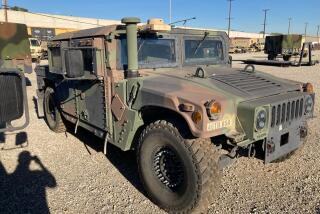‘Twas a Lowly Jeep That Won World War II
- Share via
My indefatigable correspondent Duke Russell has sent me a clipping from the New York Times reporting that the Army is going to replace the Jeep with something called the Hummer.
This should twang the strings of nostalgia for every man and woman who served in uniform in World War II. The Jeep was ubiquitous. It was the most useful and beloved of military vehicles. It was more crucial, in the long run, than mobile guns, tanks or even, I suspect, the battleship.
I’m sure the Jeep was involved in many actual combat situations, and I have no doubt that it served with honor. But to most GIs it will be remembered with affection as the vehicle of leisure, of liberty, of non-military but life-enhancing missions.
Anybody who has ever seen a war movie is familiar with the Jeep, that sturdy little boxlike vehicle with two seats front and back, no top and a snub nose. It is the vehicle U.S. generals are shown riding in when they visit the field. (German generals ride in Mercedes phaetons.)
It was the vehicle in which John Hodiak, as a major, entered the war-stricken Italian village of Adano, in “A Bell for Adano,” and the vehicle in which, having angered higher-ups, he left.
In the TV series “MASH,” Hawkeye and Hotlips had their only romantic clinch when they were out riding in a Jeep and were forced to take cover from enemy fire.
As a mere noncom in the Marine Corps, I did not often have access to a Jeep. But once on Maui, when I was doing public relations for the Fourth Division, I was assigned a Jeep and a photographer and told to find a model young Marine and a pretty girl from one of the nearby towns and show them romancing at Maui’s picture places.
I found the Marine, and I found the girl in Wailuku, and we drove them in our Jeep from the Fourth Division camp, in the valley below Haleakala, to Hana, which was said to have the island’s most beautiful beach. There was then no real road--only a roadbed that had been dynamited out. It was full of holes and boulders. It was a bone-jarring trip. The model Marine and I rode in back, which bounced harder. We posed the Marine and the girl on the pristine beach--there was nothing there then but an agricultural station--and then drove back. I was so shaken up by the ride that I had to spend three days in sick bay.
On about D-plus-5 on Iwo Jima I was holed up in a wrecked Japanese concrete bunker when an enlisted man came by in a Jeep. He was lost. I persuaded him to drive me over the battlefield to Fifth Division headquarters, at the foot of Mt. Suribachi, on the promise that I could get some booze there. I was a friend of the Fifth’s medical officer, and I knew that he would have an oversupply of medicinal brandy, if I could find him.
Fifth Division headquarters was merely a number of shell holes covered by tarpaulins. I asked from one to the next until I found my friend. He was sitting alone in his hole, surrounded by medical supplies. He appeared to be in shock, but he revived and greeted me warmly. I explained my mission and he gave me an armful of brandy in two-ounce bottles. The driver was well rewarded for driving me, and that night I shared the rest with my companions in the bunker.
After the war I was stationed for a while in Pearl Harbor, writing stories about Marines who had been imprisoned throughout the war by the Japanese. I wanted to go home. I had a son I hadn’t seen. I kept bugging the colonel. He finally told me, “I want to go home, too, Smith.”
“But you have a Jeep, colonel,” I told him. “And a girlfriend,” I added maliciously. Two weeks later I was on a midget aircraft carrier, headed toward San Diego and home.
The Army says the Hummer is “substantially larger and far more versatile than the Jeep,” and “the troops love them.”
“I weepeth,” Duke says, “but that’s good enough for me. Survival is the name of the game.”
Oh, well, we still have those old movies.
More to Read
Sign up for Essential California
The most important California stories and recommendations in your inbox every morning.
You may occasionally receive promotional content from the Los Angeles Times.












